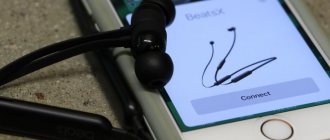Your phone's speaker grille is constantly exposed to a variety of impacts, even when it's in a case. Despite the fact that the manufacturer tries to protect such areas in the device as much as possible, dust, water or mechanical stress can still damage or contaminate the speakers. This often results in reduced audio volume or, worse, a non-functioning speaker.
Fortunately, if you have such a problem, you don’t always need to immediately run to a service center. Here are some troubleshooting steps you can use to try to revive your Android phone's speaker.
Check for software problems
Before we dive into troubleshooting your phone's speakers, you should make sure that the problem is a hardware issue. There are several ways to do this.
- 1. The first step is to simply reboot. This will restart all background services and clean up your phone in case anything has gone wrong since your last reboot.
- 2. Next, you need to check if your phone's audio output is set to the built-in speaker. If you regularly connect your phone to wireless headphones or speakers, it may remain connected to another device. Go to Settings > Connected Devices to see if your phone is connected to any Bluetooth devices. After that, you should go to the "Sound Settings" section and make sure that you have not accidentally turned on the Do Not Disturb and Quiet modes.
- 3. Additionally, we recommend testing the speaker by turning the volume down to the minimum level and then turning it up to the maximum level. Try playing music at both levels to make sure it's not a volume control glitch.
- 4. Since the music app may also not work properly, a more convincing way to check is to play the ringtone or alarm in your phone's audio settings. You can do this by going to Settings > Sound > Phone Ringtone and choosing from the many available options. When doing this, make sure that the sound volume is not at zero.
What to do if there is no sound on your phone
If there is no sound on your smartphone, then first you need to look at the settings. It is quite possible that the volume on the mobile device is at a minimum, so the user does not hear calls, and there is no sound when playing a video.
Change settings
If the sound disappears suddenly and for no apparent reason, it is first recommended to check the volume control. It is regulated in many smartphones with the volume button, which is located on the left. You can also find this button through the settings.
Tatiana
I follow news on the mobile services market. Always up to date with the latest events
Ask a Question
Question to the expert
The sound disappears from time to time. What to do?
Sometimes the slider is accidentally moved by the user when he is taking screenshots. It is recommended to check the settings if the sound has not completely disappeared, and only in certain applications. This problem is solved by adjusting the sound directly in the application itself, for example, in a music player or game. Sometimes the problem is due to the fact that the wrong player is being used. In this case, it is enough to download another version of the player, and then restart your smartphone.
Check headphone mode
The reason for the lack of sound may be the connected headset. As soon as the headphones are connected to the smartphone, the system automatically detects them and mutes the sound on the device itself. Occasionally, a problem arises when, even after removing the headphones, the system seems to freeze in this state. In this case, you can try several options:
- You should insert the headphones again, and then pull them out. Now it’s worth trying to change the volume level and adjust it;
- If the previous option did not work, then you should restart your mobile phone, first removing the headphones from the jack.
In most cases, using these methods you can solve a program with a frozen smartphone. If this does not help, then the problem lies elsewhere.
The reason for the disappearance of sound may be the activated “quiet”, “silent” or “airplane” mode. This problem is solved by returning to standard settings.
Reset settings to factory defaults
If after adjusting the settings the sound still does not appear, you can try resetting the settings to factory settings. But it should be taken into account that in this case a lot of useful information will be deleted from the mobile device, so it is first recommended to transfer it to a flash drive or computer.
https://www.youtube.com/watch?v=9V26WelV-Wk
Check SD card
A huge amount of information is stored on the memory card, including the application cache, all data from installed applications, photos, music, videos and games.
When some new applications are installed, the memory card becomes even more clogged, which can lead to various problems, including with sound. This happens quite rarely, but this option cannot be ruled out. Therefore, it is recommended to periodically clear the memory card of unnecessary files.
Try reboot
Sometimes the sound on the phone disappears out of the blue, without any obvious reason. If no problems are visible in the settings, then you can try restarting your mobile device. In many cases, this manipulation helps restore sound.
Check your phone for viruses
Viruses most often arrive on a smartphone along with applications downloaded from an unknown source. If there is no sound on your mobile phone, then you need to remember what programs were recently installed and where they came from. It is recommended to remove all suspicious applications. After this, the phone is rebooted and the sound is checked.
To protect against viruses, you should install a modern version of an antivirus program on your smartphone. You can find a suitable option in the same Play Market. Most of these programs have a trial period when they can be used completely free of charge.
Manually disable headphone output
When you unplug accessories from the audio jack, Android may not handle this event, causing your phone to be stuck in headphone mode. This means that your speaker will be muted even though you have disconnected your headphones.
You can usually fix this problem with a standard reboot. But if this doesn't help, you can try a specialized application from the Market, for example, Disable Headphone. Disabling headphones with one click of a switch allows you to manually wake your phone from headphone mode and play sound through its speakers.
Changing the volume in the settings menu
You can try to troubleshoot the problem yourself by restoring the system to factory settings. Just click on the “Settings” icon located in the menu and select the “Volume” option (the name varies depending on the current version of the operating system). A list of available profiles should appear, with separate adjustments for the earpiece and stereo speakers. You can set up playback on headphones.
After checking the volume controls and settings, check to see if the speaker is functioning normally. Has anything changed? We continue checking.
Try Safe Mode
Android allows you to run a mode in which only the original software that came with the phone is loaded. This helps you troubleshoot your phone without any third-party services or apps interfering with your diagnostics. It is called safe mode and is present on every Android phone.
To enter Safe Mode, press and hold the Power button. From the selection menu that appears, press and hold the Power button, then press OK when prompted to boot into Safe Mode. You can easily exit Safe Mode by restarting your phone. These instructions are relevant for a system without major changes to stock Android; if you have a highly customized shell, for example, miui from Xiaomi, the actions may be different. If nothing comes up when you try the steps above, try searching Google for your model or visit the official support forums.
Silent Android Speakers
Often the reason why the sound on the phone does not work is situations when the external/internal Android speaker stops working suddenly, in which case the device does not make any sound at all. And also when calling others, they hear nothing. If there is no audibility even in the headphones, then this is probably a hardware problem. You need to check the external and internal Android speaker using the Device Diagnostic Tool.
Diagnostic algorithm - how to find out why there is no sound on a Samsung S4 phone:
- Open the hardware kit and enter the key combination * #7353 # to enter the Device Diagnostic Tool menu.
- For an external speaker, tap the Speaker icon. If it is working normally, you will hear very loud music coming from the device.
- Press "Speaker" again to mute the sound.
- For the internal speaker, press the “Melody” key. If everything is fine with the speaker, music will come out of it.
- If the device does not pass the test, then the problem is in the software.
In this case, you can use the following tips:
- Reboot the phone in the usual way.
- Turn off Bluetooth, sometimes the speaker does not work because the device is connected to this device.
- If everything is done correctly, then the sound will appear, if not, then the reason explaining why there is no sound on the phone may be a hardware problem, then you will have to send it for repair.
Clean the speaker grilles
As mentioned earlier, your smartphone's vents often accumulate dust and dirt over time. This may interfere with their ability to produce sound. At this point, you should try to clean the speaker grill yourself to remove any debris.
You can start by blowing air into the speakers using a special bulb or can of compressed air. Alternatively, you can try to remove small crumbs and dust pieces using a vacuum cleaner. This may affect the internals of the phone, so be careful if you try this.
Another good option is to gently brush the speaker grilles with a toothbrush, which will loosen any dirt. If you feel able to do this and your phone is easy to disassemble, you can try this and blow out the dust from inside.
iPhone sound problems
The problem of no sound on iPhone is one of the most common, along with the camera not working.
The most common types:
- The phone doesn't ring well.
- You can't listen to music without headphones, the volume is gone.
- No sound is heard from the speaker.
The user does not need to rush to Apple service. Many problems can be solved on your own:
- The first reason why there is no sound coming from the device is that the volume may have been set to the lowest level or the device may have been turned off. It's better to check this first.
- The next factor to check is the wrong application, especially audio. For example, the user does not hear sound only when watching a video via YouTube. In this case, it could be an isolated problem in the video file, or YouTube itself could be crashing.
- You can try using other video/audio applications on the device and if other applications work, then the problem is only with YouTube.
- Installing the wrong updates and programs on your device can also cause this issue. If the user started hearing sound coming from the device after installing a new update, then it is the cause and should be removed.
Perform a hard reset
Testing your phone in Safe Mode as above will rule out the possibility that a third-party app is the culprit. If your phone's speakers were working properly in Safe Mode, you can try to isolate the problem to a specific app, setting, or device. If you're having trouble with your speaker only after making changes to these settings, try undoing what you changed.
Otherwise, you can perform a hard reset. You can do a factory reset even if going into Safe Mode didn't have any effect. By doing this, your phone starts up again and you eliminate the possibility of any software glitching that is causing the speakers to not work. The reset option can often be found in Settings > System > Advanced > Reset Settings. This path may vary depending on the version of Android and your device model. Please remember that this action will erase all your data, so be sure to make a backup before doing this.
Three groups of reasons
To make it easier to understand which direction to dig in, the first thing you need to do is determine where the source of the problem is. The reasons for the “deafness” of smartphones, like other electronic devices, are divided into 2 main groups – hardware and software. And software ones, in turn, are related to the operating system and applications.
The source of the problem can roughly be localized based on the symptoms listed below. But it happens that the signs point to one thing, but in fact the reason is something else. Perhaps even in several factors from different groups.
The malfunction is most likely in the hardware if:
- There is no sound in only one of the output devices, for example, in the speaker, but it plays normally through the headset.
- The sound disappears when you increase/decrease the volume, press buttons, move the jack with connected headphones, etc. That is, when there is a mechanical impact on the device.
- The problem occurred immediately or a short time after the phone was dropped, hit, or got wet.
- The loss of sound is accompanied by another obvious malfunction that appeared around the same time, for example, cracks in the screen.
- Before the sound disappeared completely, there were other problems associated with it - deterioration in quality (noise, distortion), periodic dropouts, decreases or jumps in volume, etc.
The reason is probably in the operating system if:
- The sound disappeared after the phone was in the hands of an inexperienced user, for example, a child. More often it is associated with changing settings, for example, switching the device to silent mode or switching the sound output to Bluetooth headphones. However, childish play can also lead to the deletion (moving) of audio files, including system ones.
- Before the event, the user installed Android updates, changed audio settings in the engineering menu (by the way, experiments with the engineering mode can lead to hardware failure of the phone), installed or removed patches, codecs, etc.
- The lack of sound was discovered after installing a new OS (firmware), but in the old one it worked as it should.
- Simultaneously with the disappearance of the “voice,” other system problems or signs of malware were discovered: blocked functions, disappearing buttons, pop-up advertisements, etc.
On Android smartphones with root rights, any interference with the structure and functions of the OS is potentially dangerous, as it can lead to irreversible damage to the system. This also includes installing applications from unofficial sources.
A third-party program is to blame for the malfunction if:
- There is no sound only in it. For example, if you cannot hear the person you are talking to on Skype, but calls via WhatsApp are working fine, you should look for the source of the problem in Skype.
- The new program quietly replaced the one that was previously used by default. For example, instead of the standard “Phone” application, another one was installed, and it is either not configured or “buggy”. Because of this, you may not hear the signal for an incoming call or SMS delivery.
- The program you use to play audio, such as a music player, is blocked, corrupted, or removed from your device. Or maybe it simply does not support the file format that you are trying to “feed” it (there are no necessary codecs).
The reasons for interruptions in the operation of audio and calling software may be errors in the software itself, conflicts with other applications, blocking or forced termination by memory controls and antivirus programs.
Got water? Let it dry
One of the most common consequences of water getting into a smartphone is a malfunction of the speaker. Liquid can quickly penetrate inside the phone due to the holes in the speaker grille. Therefore, if you have had problems with your speakers after water has entered your device, let your phone dry.
What to do if water gets into your phone speaker? There are several ways to dry a wet phone. You can blow hot air on it, stick it in a bowl of rice, and more. But whatever you do, turn off your phone immediately and let it dry completely before trying to boot it up again. It should be borne in mind that water is very treacherous, and even if problems do not appear immediately, a malfunction may overtake your phone later. It is better, after you have drowned or flooded your device, to still take it to a service center for preventive maintenance.
Is there a problem with the system? We decide for ourselves
What to do in the most common situation - when problems arose due to changes in system settings, we figured it out: it is enough to return the latter to their original state. In difficult cases, for example, if you cannot understand what exactly broke the sound, the following, more radical measures often help:
- one by one removing all applications that were installed or updated shortly before the breakdown;
- checking your phone for malware;
- restoring factory settings (reset, rollback) using system functions or hardware.
The last point is the last resort, which is resorted to if all simpler solutions have been tried and none have helped. The only more radical option is flashing, that is, reinstalling the smartphone’s operating system with the loss of all data. However, a reset may also be useless if the device is rooted - deep changes (deleting system files and programs, operations through the engineering menu) made with superuser rights are not rolled back.
By the way, before resetting to factory settings, do not forget to copy important files to another drive or to the cloud.
If a sound problem was discovered after updating Android and you previously saved a backup copy of your data, restore the system from it. If a valid copy is not available, or if a failure occurs after flashing the device, the only solution is to reinstall the system. When choosing a distribution, it is important to make sure that it is compatible with your smartphone model and revision.











